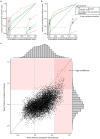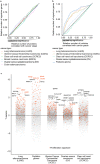Identifying the genes impacted by cell proliferation in proteomics and transcriptomics studies
- PMID: 36201535
- PMCID: PMC9578628
- DOI: 10.1371/journal.pcbi.1010604
Identifying the genes impacted by cell proliferation in proteomics and transcriptomics studies
Abstract
Hypothesis-free high-throughput profiling allows relative quantification of thousands of proteins or transcripts across samples and thereby identification of differentially expressed genes. It is used in many biological contexts to characterize differences between cell lines and tissues, identify drug mode of action or drivers of drug resistance, among others. Changes in gene expression can also be due to confounding factors that were not accounted for in the experimental plan, such as change in cell proliferation. We combined the analysis of 1,076 and 1,040 cell lines in five proteomics and three transcriptomics data sets to identify 157 genes that correlate with cell proliferation rates. These include actors in DNA replication and mitosis, and genes periodically expressed during the cell cycle. This signature of cell proliferation is a valuable resource when analyzing high-throughput data showing changes in proliferation across conditions. We show how to use this resource to help in interpretation of in vitro drug screens and tumor samples. It informs on differences of cell proliferation rates between conditions where such information is not directly available. The signature genes also highlight which hits in a screen may be due to proliferation changes; this can either contribute to biological interpretation or help focus on experiment-specific regulation events otherwise buried in the statistical analysis.
Conflict of interest statement
The authors have declared that no competing interests exist.
Figures





Similar articles
-
Signatures of cell death and proliferation in perturbation transcriptomics data-from confounding factor to effective prediction.Nucleic Acids Res. 2019 Nov 4;47(19):10010-10026. doi: 10.1093/nar/gkz805. Nucleic Acids Res. 2019. PMID: 31552418 Free PMC article.
-
Integration analysis of quantitative proteomics and transcriptomics data identifies potential targets of frizzled-8 protein-related antiproliferative factor in vivo.BJU Int. 2012 Dec;110(11 Pt C):E1138-46. doi: 10.1111/j.1464-410X.2012.11299.x. Epub 2012 Jun 28. BJU Int. 2012. PMID: 22738385 Free PMC article.
-
Integration of Proteomics and Transcriptomics Data Sets for the Analysis of a Lymphoma B-Cell Line in the Context of the Chromosome-Centric Human Proteome Project.J Proteome Res. 2015 Sep 4;14(9):3530-40. doi: 10.1021/acs.jproteome.5b00474. Epub 2015 Aug 5. J Proteome Res. 2015. PMID: 26216070
-
Integrating transcriptome and proteome profiling: Strategies and applications.Proteomics. 2016 Oct;16(19):2533-2544. doi: 10.1002/pmic.201600140. Epub 2016 Aug 25. Proteomics. 2016. PMID: 27343053 Review.
-
Evolutionary Transcriptomics and Proteomics: Insight into Plant Adaptation.Trends Plant Sci. 2017 Jun;22(6):462-471. doi: 10.1016/j.tplants.2017.03.001. Epub 2017 Mar 30. Trends Plant Sci. 2017. PMID: 28365131 Review.
Cited by
-
Identification of unique cell type responses in pancreatic islets to stress.Nat Commun. 2024 Jul 2;15(1):5567. doi: 10.1038/s41467-024-49724-w. Nat Commun. 2024. PMID: 38956087 Free PMC article.
-
Polymerase theta expression is correlated with proliferative capacity but not with DNA repair deficiency status in solid tumors.NPJ Precis Oncol. 2025 Jun 20;9(1):200. doi: 10.1038/s41698-025-01000-w. NPJ Precis Oncol. 2025. PMID: 40542116 Free PMC article.
-
Resistance of HNSCC cell models to pan-FGFR inhibition depends on the EMT phenotype associating with clinical outcome.Mol Cancer. 2024 Feb 21;23(1):39. doi: 10.1186/s12943-024-01954-8. Mol Cancer. 2024. PMID: 38378518 Free PMC article.
-
Sodium acetate increases the productivity of HEK293 cells expressing the ECD-Her1 protein in batch cultures: experimental results and metabolic flux analysis.Front Bioeng Biotechnol. 2024 Apr 10;12:1335898. doi: 10.3389/fbioe.2024.1335898. eCollection 2024. Front Bioeng Biotechnol. 2024. PMID: 38659646 Free PMC article.
-
Brain-body mitochondrial distribution patterns lack coherence and point to tissue-specific regulatory mechanisms.Life Metab. 2025 Apr 12;4(3):loaf012. doi: 10.1093/lifemeta/loaf012. eCollection 2025 Jun. Life Metab. 2025. PMID: 40487563 Free PMC article.
References
Publication types
MeSH terms
LinkOut - more resources
Full Text Sources

